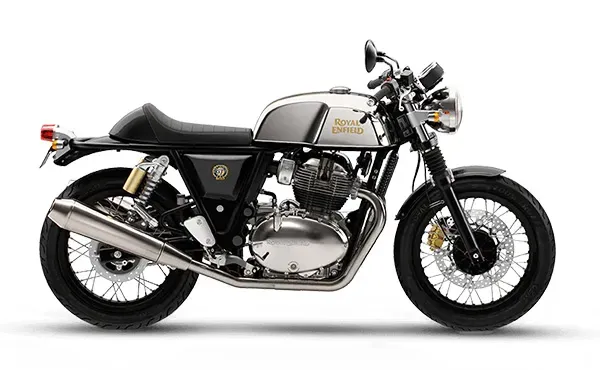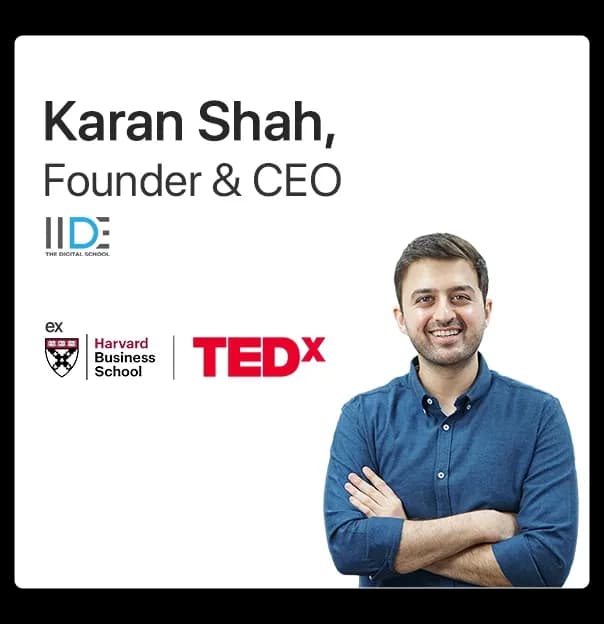🚀 Just Launched — Our New Undergraduate Program in Digital Business & Entrepreneurship is Here: Explore Now!
Royal Enfield’s marketing strategy focuses on digital platforms, influencer collaborations, and experiential marketing to engage a global audience. The brand uses Instagram and YouTube to share lifestyle content that educates consumers about motorcycling culture, positioning its bikes as symbols of adventure.
By leveraging SEO, content marketing, and credible influencers, Royal Enfield builds trust and positions its products as solutions for exploration and freedom.
Aditya Shastri
Lead Trainer & Business Development Head at IIDE
Updated on: Jul 17, 2025
About Royal Enfield

Royal Enfield is an iconic motorcycle manufacturer known for blending classic designs with modern technology.
Founded in 1901 in the UK, Royal Enfield has become synonymous with rugged, long-lasting motorcycles, especially popular in India and international markets.
The brand operates within the motorcycle and automotive industry, competing against global and regional players such as Harley-Davidson, Bajaj, and Yamaha.
Since the brand's acquisition by Eicher Motors in 1994, Royal Enfield has experienced tremendous growth.
In 2025, the brand’s sales exceeded 1,009,900 units sold globally, with a significant rise in international markets.
Its global presence spans across more than 50 countries, including North America, Europe, and Asia, with India being the largest market.


Learn Digital Marketing for FREE


Marketing Objective or Business Challenge
Royal Enfield's marketing objective is to strengthen brand presence both locally and globally. While the brand dominates the Indian market, its key challenge is expanding in Western markets, competing with giants like Harley-Davidson.
To achieve this, Royal Enfield needs to increase brand recall and engage younger audiences who demand digital engagement and modern customer experiences.
The brand aims to balance nostalgia with innovation, maintaining its legacy while appealing to digitally savvy consumers.
Specific hurdles include market penetration and consumer hesitation, especially in markets where brand recognition is low. Royal Enfield is working on repositioning itself to resonate with both legacy-driven customers and younger riders.
Metrics like website bounce rates, SEO performance, and social media engagement are crucial to refining this approach, ensuring the brand stays relevant while boosting sales globally.
Buyers Persona:

Himanshu
Occupation: Working Profession
Age: 18-40 years old
Motivation
- Seeking motorcycles that offer both performance and style.
- Desire for a sense of freedom and adventure.
- Interest in owning a classic yet modern bike with long-lasting quality.
Interest & Hobbies
- Enjoy exploring new places and riding on long road trips.
- Passionate about motorcycle culture and mechanics.
- Engage in motorcycling communities (online forums, social media groups).
- Love customising their bikes and exploring related gear and accessories.
Pain Points
- Concerned about the balance between cost and quality.
- Struggling to find a motorcycle that combines modern technology with a vintage design.
- Face difficulty in accessing service centres in remote locations.
Social Media Presence
- YouTube
Marketing Channels Used by Royal Enfield
Royal Enfield's marketing strategy in 2025 revolves around a robust digital-first approach, complemented by traditional media and immersive experiences.
Digital Marketing
- SEO & SEM: Royal Enfield's SEO performance in 2025 resulted in 8.1 million organic search traffic and 189,600 paid search traffic.
- Social Media: The brand maintains a strong presence on various social media platforms, including Instagram, Facebook, YouTube, and Twitter. For instance, their Instagram account boasts over 3.4M followers, where they share home decor inspiration, DIY tips, and engage with users through contests and challenges.
- Email Campaigns: Royal Enfield utilises email marketing to enhance user engagement, incorporating automated emails, newsletters, and promotions to maintain customer interest and drive conversions.
Experiential Marketing
- Events & Rides: The brand organises events like Rider Mania and the Himalayan Odyssey, fostering community engagement and brand loyalty.
- Brand Collaborations: Royal Enfield has engaged in strategic collaborations, such as the 'Infinito System' campaign, developed in partnership with Moonfolks, to address wall-related issues.
Royal Enfield Marketing Strategy Breakdown
Royal Enfield continues to strengthen its position by combining digital marketing with immersive experiential strategies.
The brand’s SEO efforts drive 6.8M monthly visits, with 61.91% of traffic from organic search.
Paid ads on platforms like Google Ads and Meta Ads target adventure enthusiasts, improving customer engagement and conversion rates.
Social media is a central part of Royal Enfield’s strategy, with Instagram hosting over 3.4M followers.
The brand actively engages its audience through user-generated content, road trip diaries, and product showcases.
Email campaigns, with a 42.35% open rate, further nurture customer engagement, offering personalised updates and promotions.
The brand’s influencer marketing focuses on collaborations with both macro and micro-influencers, helping expand its reach to a wider audience.
Additionally, experiential marketing efforts, such as riding events and community-building activities, deepen brand loyalty.
Results & Impact
Revenue: Royal Enfield reported ₹33,797 crore in FY 2025, a 4.5% decline year-over-year, attributed to the dip in certain decorative segments. However, premium products saw strong growth.
Website Traffic: The official website attracted 3.7 million visits monthly, with 35% growth and a bounce rate of 39.8%.
Engagement Metrics: Instagram engagement increased by 50% following strategic influencer campaigns.
SEO & Search Ranking: Royal Enfield ranks for 874K keywords and garnered 201K backlinks, contributing to an increase in organic search traffic.
Influencer Marketing Impact: Influencer collaborations led to a 25% increase in brand awareness, enhancing engagement across Instagram and YouTube.
App Engagement: With 500,000 downloads, the Royal Enfield app boosted customer engagement through features like map navigation and real-time tracking.
What Worked & Why
Royal Enfield’s marketing strategy succeeded due to its ability to blend its heritage with modern digital strategies.
The strong brand identity combined with immersive content, especially user-generated stories, fostered deeper emotional connections with consumers.
The seamless integration of offline experiences, such as "The Great Escapade," with digital campaigns further amplified engagement.
Collaborations with motorcycling influencers and a focused social media strategy have greatly enhanced brand trust and visibility.
What Did Not Work & Why
Royal Enfield’s attempt to launch budget-friendly variants to attract a broader audience did not succeed.
The brand’s premium positioning in the market created a mismatch with lower-priced models, leading to limited success.
Additionally, some campaigns failed to resonate with younger, more digitally-focused consumers who were looking for more immersive, tech-driven experiences.
The lack of digital engagement at dealerships and a disconnect with younger buyers seeking innovation beyond traditional motorcycling culture also contributed to the challenges faced in reaching new audiences.
IIDE Student Recommendations: Key Areas for Brand Improvement
Royal Enfield has successfully established itself as a premium motorcycle brand, but in order to stay ahead of competitors and drive growth, there are key areas where the brand can enhance its marketing strategy. Here are practical, actionable recommendations to ensure higher sales and revenue:
1. Enhance Customer Experience
Key Tactic: Invest in virtual showrooms and augmented reality (AR) experiences, allowing customers to explore bikes remotely and customise their models.
Why: Virtual experiences will offer a personalised, immersive shopping journey, particularly valuable for tech-savvy and younger customers. This will not only increase engagement but also reduce barriers for those unable to visit physical stores.
2. Boost Global Influencer Collaborations
Key Tactic: Expand partnerships with younger, lifestyle-focused influencers on platforms like Instagram, YouTube, and TikTok.
Why: Influencers in the adventure and motorcycling spaces can help Royal Enfield tap into a broader audience, particularly millennials and Gen Z, who seek authentic, experience-driven content. This will elevate the brand’s visibility and generate leads.
3. Increase Focus on Sustainability
Key Tactic: Introduce electric and hybrid models alongside traditional motorcycles, emphasizing sustainable manufacturing processes.
Why: Eco-conscious consumers are increasingly prioritizing sustainability in their purchasing decisions. By launching electric models, Royal Enfield can cater to this growing segment and appeal to environmentally aware buyers.
4. Offer Subscription-Based Models
Key Tactic: Implement flexible leasing or subscription options for motorcycles.
Why: Younger, budget-conscious customers are seeking flexibility. Subscription models allow more people to access Royal Enfield’s products without the long-term commitment of ownership, driving up sales and providing recurring revenue.
5. Localised Marketing Campaigns for Global Markets
Key Tactic: Tailor campaigns to regional preferences, such as focusing on sustainability in Europe and affordability in Southeast Asia.
Why: Localised marketing campaigns will resonate more deeply with customers, fostering a stronger connection with the brand. This can improve engagement and conversion rates across diverse markets.
6. Focus on Post-Sale Engagement
Key Tactic: Develop a community platform that enables customers to share their experiences and access exclusive content.
Why: Engaging customers after the sale strengthens brand loyalty and encourages repeat purchases. A robust post-sale community will keep customers invested in the brand in the long term.
7. Leverage AI and AR Technologies
Key Tactic: Integrate AI tools for bike customisation and AR for a virtual showroom experience.
Why: Personalisation drives higher engagement and conversions. Allowing customers to customise their bikes and visualise them in real time will enhance their buying experience and increase sales.
Want to Know Why 5,00,000+ Students Trust Us?
Dive into the numbers that make us the #1 choice for career success

Aditya Shastri leads the Business Development segment at IIDE and is a seasoned Content Marketing expert. With over a decade of experience, Aditya has trained more than 20,000 students and professionals in digital marketing, collaborating with prestigious institutions and corporations such as Jet Airways, Godrej Professionals, Pfizer, Mahindra Group, Publicis Worldwide, and many others. His ability to simplify complex marketing concepts, combined with his engaging teaching style, has earned him widespread admiration from students and professionals alike.
Aditya has spearheaded IIDE’s B2B growth, forging partnerships with over 40 higher education institutions across India to upskill students in digital marketing and business skills. As a visiting faculty member at top institutions like IIT Bhilai, Mithibai College, Amity University, and SRCC, he continues to influence the next generation of marketers.
Apart from his marketing expertise, Aditya is also a spiritual speaker, often traveling internationally to share insights on spirituality. His unique blend of digital marketing proficiency and spiritual wisdom makes him a highly respected figure in both fields.